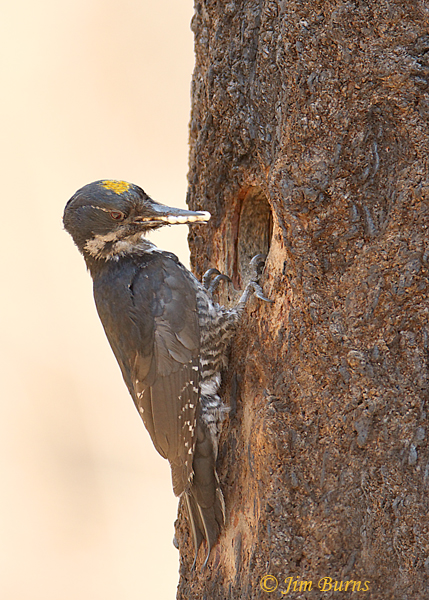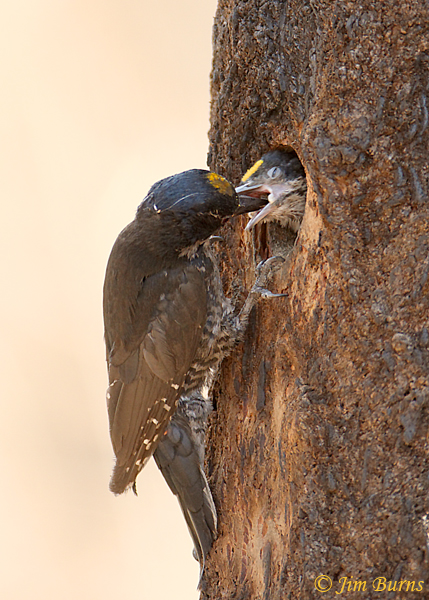
Except that the sound is neither loud nor harsh, "ratcheting" would be its most descriptive adverb. It is not a sound which startles and causes the head to snap quickly and swivel about. Rather, it is soft and subdued, insidious and seemingly very close, and the head turns slowly yet the eyes glance wildly in every direction like those of a child sure he has heard the monsters beneath the bed but fearful of disclosing to them that knowledge. There is nothing there, of course, just the ashes at your feet, swirling perhaps in a slight draft of mountain air. And the sound.
As it insinuates itself into your soul, this sound, this song without a singer, seems so close you begin to feel rather than hear it, gnawing on your bones, sawing into your skull, and you're pretty sure you're going crazy and you know you want to scream. And then, out of the dream, the woodpecker finds you, rescues you as it were, snaps you back to reality. It is a Black-backed. A male, its yellow crown patch a welcome ray of bright relief on the dark palette of the dreary burn, its purpose in life a reminder of what you know the sound must be, counterintuitive though it seems.
Rita Dixon and Victoria Saab, in the introduction to their species account of Black-backed Woodpecker in Birds of North America, call it "one of the most enigmatic woodpeckers . . . because of its general rarity." I'd think so! I've seen three in my birding life, the male now "going off" and throwing a fit twenty feet up in the ponderosa three trees downslope from me is the third. I am still so hung up on the mysterious ratcheting, now drowned out by the woodpecker's "scream-rattle-snarl" alarm vocalizations, that it takes me several minutes to tune in to the other background noise and put all the obvious clues together.
Black-backed Woodpecker and its congener, American Three-toed Woodpecker, are attracted to burns because burns attract favored prey, wood-boring beetles for the former, bark beetles for the latter. And that sound you hear in old forest burns, though it is hard to believe at first hearing, is actually the chewing of beetle larvae through the cambium into the sapwood of the host tree. The human brain, not evolved to hear noises in nature without the possibility of getting a visual on the noise maker, is even more at a loss computing sound emanating from inside a tree. I've heard "tree noises" twice now, the first in the old Leroux Burn northwest of Flagstaff, Arizona where a colony of Three-toeds had taken up residence. You can be sure the woodpeckers hear and recognize the sound.
I have read that the invasive beetles smell the chemicals in the smoke from the burning wood and arrive at the burn almost before the fire plays out. I cannot, however, find anything in the birding literature about how Black-backeds and Three-toeds find the burn. I would like to speculate that they, too, have evolved a sense of smell sensitive to burning wood chemicals, but both species are known to be irruptive, long distance wanderers, so it may simply be a matter of the woodpeckers searching visually for smoke, burned areas, or tracts of dead trees.
One of the Black-backed's favored wood-boring beetle prey bears the common name White-spotted Sawyer and, as I shake myself awake from the momentary bad dream of singerless songs from the depths of barkless trees, I reflect upon the aptness of this factoid of Picidae natural history. It is the second part of this borer's name, not the first, that fascinates me. To my knowledge, I've never seen a White-spotted Sawyer, but "sawing" may be a better descriptive adverb than "ratcheting." In my mind's eye I see two tiny larva with an even tinier crosscut saw, push-pulling away deep in the cambium layer of the tree directly behind me, so close I have been very careful, remembering how difficult it is to remove charcoal marks from clothing, not to brush against it. Then I remember a reference to "larval galleries," and I see a whole colony of tiny sawyers diligently at work honeycombing their way through the dense wood.
As I give thanks that the sawyers are, in fact, in the surrounding ponderosas and not actually inside my head, I finally realize that the male Black-backed is not going away, is not quieting down, is not really foraging. He is yelling at me. I am in his territory, invading his territory as it were, and the steady, low level screeching in the background finally clicks in, much louder and more intrusive than the ratcheting had been. I have stumbled onto a nest, with hungry nestlings!
Mark Houston, my friend and a long time observer/expert on all things natural in eastern Washington state, has not gotten hung up on the sawyers in my head. He has walked downslope twenty yards, turned around, and looked directly into the north-facing nesthole from which the Black-backed nestlings are screeching incessantly. He backs off quickly, gives me a thumbs up, then leaves to see how many other Black-backeds he can find in the extensive burn. As I settle in, a respectful distance away and stop moving about, Mr. Woodpecker settles down and begins to forage again.
Trips to the hole with food items occur every ten minutes or so. Trips away from the hole are typically close by, well within my range of vision, but occasionally up to 100 yards away. The menu includes both adult and larval stage beetles, something that looks like a wasp, multiple small white egg sacs, half a dozen or more to an adult billful, and something from several explorations in the same area on the ground which must be ants. Oddly, to my original way of thinking, Mrs. Woodpecker is never seen, never enters the scene. The answer to this riddle of the missing female parent seems to lie in the BNA species account.
Young Black-backeds are apparently well known for their voracious and aggressive feeding behavior, and it is thought that female adults, smaller than males, may often cease nest feeding after the nestlings reach a certain stage (size) in their development lest they be injured by the hungry young. Observant birders have noticed in many species that feeding parents often close their eyes as young reach and stab at delivered prey items, another example of a parental mechanism to avoid injury. Evolutionary precaution seems to work in the opposite direction also. Though the yellow crown patch of the adult male Black-backed is absent in adult females, juveniles of both genders usually sport the bright crown patch, probably to preclude adult aggression toward their own young.
Though they are closely related, Three-toeds and Black-backeds exhibit a fascinating form-to-function evolutionary difference. Three-toeds are chip and flake specialists, and hence their preference for bark beetles, the engravers and mountain pine beetles, which they find without extensive excavation. The slightly larger, heavier Black-backeds, however, are hard core excavators adapted to take the boring beetles that live deeper in the wood because they are able to start their blows from farther away and strike with more mass, thereby bringing more force into play with each blow.
Mark and I exchange mental notes as we walk up out of the charred basin. Though the two congener three-toeds both seek out forest burns and often utilize the same burns simultaneously, as might be expected they have evolved somewhat different foraging styles for somewhat different kinds of beetles in a kind of avian non-compete contract. American Three-toeds typically employ their chip and flake method in more lightly burned areas, whereas Black-backeds are usually found in more heavily torched and charred tracts. And where boundaries between these two niches blur, the larger Black-backeds always dominate. Judging from the ground ash and absence of almost all vegetation in its interior, Mark feels this was a very intense fire. Not surprisingly then, he has seen several Black-backeds but encountered no American Three-toeds.
My favorite bird families have always been those that have evolved special physical characteristics which allow them to utilize small or unique econiches shunned by others. To some extent all birds, indeed all living things, have done this, but to thrive in a vertical world of apocalyptic devastation, a black world devoid of greenery and visible signs of life, takes a most singular member of a very evolved family.
Without hyperbole Dixon and Saab could easily have called the Black-backed North America's most unique woodpecker, but Mark and I are now on our way deeper into the Okanogan where a friend has found the nest of a Great Gray Owl--another unique member in a favored family of special birds, another hunter of prey invisible to us in a world that is black, eerie, and surreal to us. The tiny sawyers have finally left my head, but I know tonight there will be dreams.
